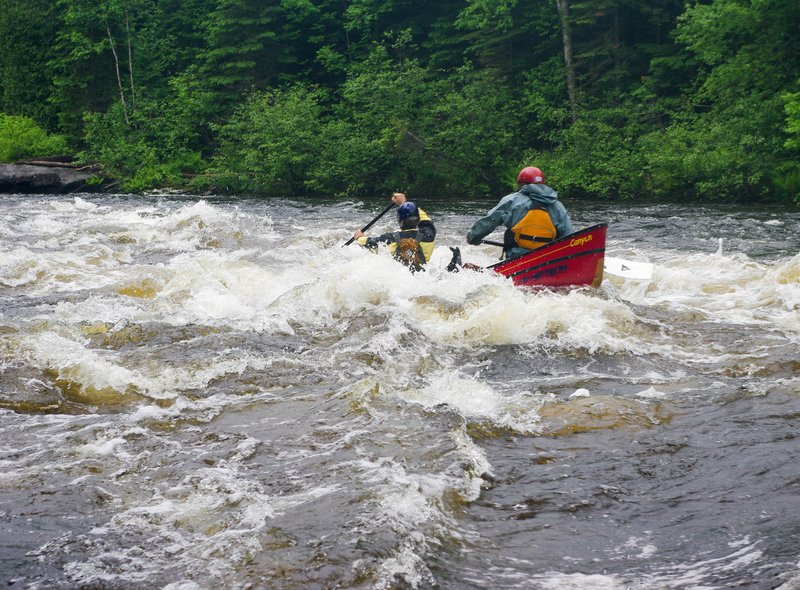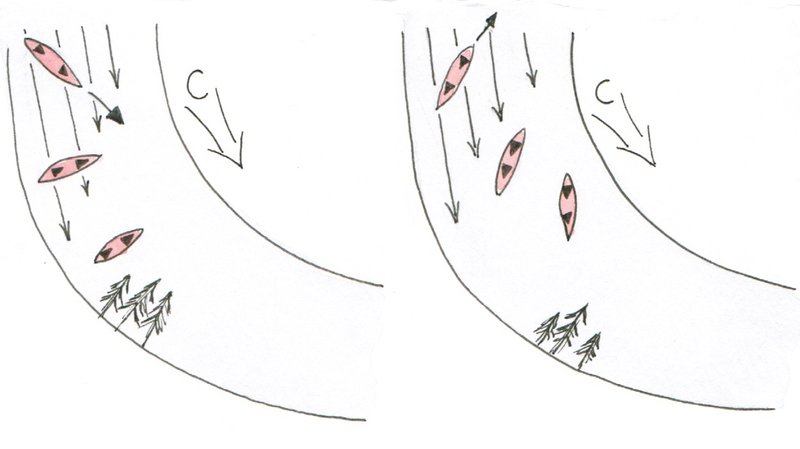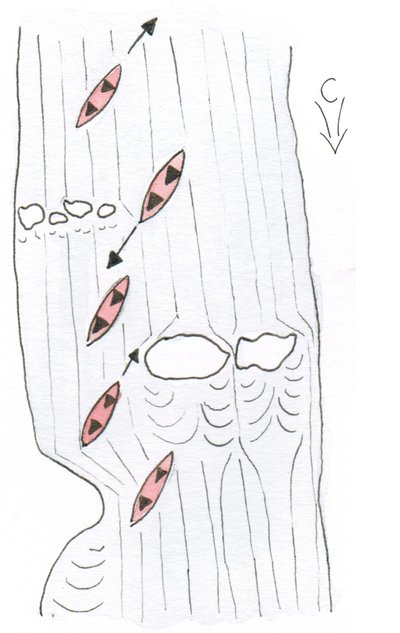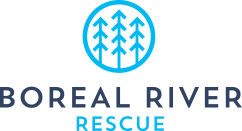Back Ferries
By Jamie Orfald-Clarke, Boreal River Rescue Instructor
While the back ferry is an important maneuver in tandem canoeing, especially with loaded boats, it is often underused. Understanding how and when to use back ferries and back paddling can build your confidence and control in a loaded canoe.

Introduction to the back ferry
The back ferry is named for its similarity to the front ferry in orientation and motion of the boat. Where the front ferry has the bow pointed upstream and across the grain of the current, with paddlers forward-paddling, the back ferry has the stern pointed upstream, with paddlers back-paddling.
It is part of a different style of paddling; running rapids under power (forward-paddling) is fast paced, and involves aggressive moves across eddy lines and around obstacles. Back-paddling, on the other hand, keeps paddlers facing downstream and slows things down, allowing a careful, controlled descent of the river. Adding back ferries to your tool box can help give you the confidence needed to run a loaded canoe down technical whitewater.
Back paddling mechanics
It takes time to develop muscle memory and become comfortable with the mechanics of the back ferry. Learn the strokes and boat control, then practice low consequence maneuvers before trying it out in more challenging situations.
Control from the bow
When paddling backwards, strokes in the bow of the boat turn the boat more effectively. This means the paddlers’ roles are reversed, with the stern paddler as the “motor” and the bow paddler as the “steering wheel.” The bow paddler can use draws and cross-draws to make major corrections, and back sweeps and reverse Js for more minor corrections.
First get comfortable with how the boat moves in reverse on flatwater. When you are ready to head into the current, continue working on boat control. Start in slow current, with the bow pointing straight downstream, and backpaddle to maintain your position. Then work on changing your angle, to move back and forth across the current. Now you are ready to incorporate back ferries into your paddling.
3 ways to use back ferries
Many beginner paddlers follow the “when in doubt, paddle forward” strategy. These are the 3 situations where I find back paddling to be most useful.
Bends in the river
At a bend in the river, most of the current collides with the outside bank, causing erosion. This means strainers usually occur on outside bends. On continuous rivers, this means constantly making maneuvers towards the inside of the bend.
One way to get to the inside of a bend with a strainer is to point the bow towards the inside, and paddle forward. Two things happen here:
- your speed moving downstream increases (current speed + paddling speed)
- turning the boat puts the bow in slower moving water, and the stern in faster water
The current speed differences will act to keep turning the boat; if you aren’t able to correct for this, you’ll be heading towards the strainer broadside, moving faster than the current.
The other option is to point the stern towards the inside of the bend, and do a back ferry. Now, the boat is moving slower than the current, and the bow is in the faster water. This gives you more time to make the move, and the different current speeds acts to straighten the boat out. While back ferries can greatly improve your control navigating river bends, they can also be tiring, since most paddlers have a harder time generating power in reverse. On large rivers, when I need to make a longer move, I often find it most effective to spin the boat and do a front ferry towards the inside of the bend. I find back ferries to be most useful on narrow rivers with tight bends where there isn’t room to spin the boat.

Back paddling through waves
Forward paddling through standing waves is a great way to swamp your boat. I think of standing waves like a bumpy gravel road. If you are going fast, you feel the full jolt of each bump. Slowing down means you can roll over bumps and potholes smoothly. Back paddling in standing waves does the same thing, slowing the movement of the boat so it can roll over the waves without taking on a drop of water. The canoe can be pointed directly downstream, or at an angle to the current. Angling the boat and keeping loose hips allows you to block the waves, and stay even more dry. The feeling of control when you get it right is incredible!
Note that this technique does not work for waves that are too steep, or for holes. Back paddling in these cases would only give more time for water to pour in, or end with the boat in a back surf! Read the water carefully, and be prepared to change quickly to forward paddling.
Crossing the grain of a rapid
While descending a rapid, movement across the grain can be accomplished by pointing with the bow and forward paddling, or by pointing with the stern and back paddling. Rather than paddling forwards for long stretches of current, or using long back ferries, both of these techniques can be used together, making it possible to maneuver back and forth across the river without turning the boat. With the bow angled left, forward strokes move the boat towards river left, and back paddling moves it towards river right. When angled right, the reverse is true. This technique allows for quick responses to multiple obstacles, especially when boat scouting.
The more comfortable you become with back ferries, the more comfortable you’ll be with switching quickly between back paddling and forward paddling. This ability to quickly switch between different techniques is key to improving your skill as a whitewater paddler.


